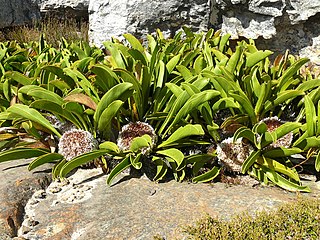
Spatalla is a genus containing 20 species of flowering plants, commonly known as "spoons", in the family Proteaceae. The genus is endemic to the Cape Floristic Region of South Africa where it is associated with fynbos habitats. The species are all small shrubs. The name is derived from the Greek, meaning “wantonness”, alluding to the plants’ unusually large pollen-presenters. Most species are threatened.

Protea cryophila, the snowball sugarbush, snow protea, or snowball protea, is a flowering shrub of the genus Protea. The plant is endemic to the Cederberg.

Protea grandiceps, commonly known as rooisuikerbos, suikerbos or red sugarbush, is a flowering shrub that belongs to the Protea genus and is native to parts south western parts of South Africa. The shrub was listed as a near threatened species in 2006 according to the South African National Biodiversity Institute.

Spatalla longifolia, the pink-stalked spoon, is a flower-bearing shrub that belongs to the genus Spatalla. It forms a part of the fynbos. The plant is native to the Western Cape of South Africa where it is found in the Hottentots-Holland Mountains; from Franschhoek and Villiersdorp to the Kleinmond Mountains.

Spatalla propinqua, the lax spoon, is a flower-bearing shrub belonging to genus Spatalla, and forming a part of the fynbos vegetation. The plant is native to the Western Cape of South Africa.

Spatalla parilis, the spike spoon, is a flowering shrub belonging to the genus Spatalla. It forms part of the fynbos. The plant is native to the Western Cape of South Africa.
Spatalla mollis, the woolly spoon, is a flower-bearing shrub that belongs to the genus Spatalla and forms part of the fynbos. The plant is native to the Western Cape of South Africa.
Spatalla argentea, the silver-leaf spoon, is a flower-bearing shrub that belongs to the genus Spatalla and forms part of the fynbos. The plant is endemic to the Western Cape Province of South Africa.
Spatalla tulbaghensis, the shaggy-hair spoon, is a flowering shrub belonging to the genus Spatalla and forms part of the fynbos. The plant is native to the Western Cape where it occurs on the Witzenberg Plains and Skurweberg Pass.
Spatalla nubicola, the Medusa spoon, is a flower-bearing shrub that belongs to the genus Spatalla and forms part of the fynbos. The plant is native to the Western Cape of South Africa where it is found in the central Langeberg near the town of Heidelberg.
Spatalla prolifera, the palmiet spoon, is a flower-bearing shrub that belongs to the genus Spatalla and forms part of the fynbos. The plant is native to the Western Cape of South Africa.
Spatalla caudata, the woolly-hair spoon, is a flower-bearing shrub that belongs to the genus Spatalla and forms part of the fynbos. The plant is native to the Western Cape Province of South Africa, where it is found in the Cederberg, Groot Winterhoek Mountains and Hex River Mountains.

Spatalla racemosa, the lax-stalked spoon, is a flower-bearing shrub that belongs to the genus Spatalla and forms part of the fynbos. The plant is native to the Western Cape of South Africa where it is found in the Kogelberg, Groenland mountains, Babilonstoringberge, Kleinrivier Mountains as well as at Villiersdorp.
Spatalla colorata, the shiny spoon, is a flower-bearing shrub that belongs to the genus Spatalla and forms part of the fynbos. The plant is native to the Western Cape Province of South Africa, where it occurs from the Riviersonderend Mountains to central Langeberg.
Spatalla ericoides the Erica-leaved spoon is a flower-bearing shrub that belongs to the genus Spatalla and forms part of the fynbos. The plant is endemic to the Western Cape of South Africa where it occurs on the Agulhas Plain near Pearly Beach, Hagelkraal and Klein Hagelkraal.
Spatalla incurva, the swan-head spoon is a flowering shrub that belongs to the genus Spatalla and forms part of the fynbos. The plant is endemic to the Western Cape of South Africa where it occurs in the Cederberg up to the Hottentots Hollandberge, Swartberg and Kammanassieberge.
Spatalla salsoloides, the kink-style spoon, is a flower-bearing shrub that belongs to the genus Spatalla and forms part of the fynbos. The plant is endemic to the Western Cape of South Africa, where it occurs in the Du Toitskloofberge's peak and Goudini Sneeukop.
Spatalla setacea, the needle-leaf spoon is a flower-bearing shrub that belongs to the genus Spatalla and forms part of the fynbos. The plant is endemic to the Western Cape of South Africa where it occurs from Slanghoek to the Hottentots-Hollandberge.
Spatalla squamata the silky spoon is a flower-bearing shrub that belongs to the genus Spatalla and forms part of the fynbos. The plant is endemic to the Western Cape of South Africa, where it occurs in the Bredasdorp Mountains and Agulhas Plain.
Sorocephalus teretifolius, the pinhead clusterhead, is a flowering shrub that belongs to the genus Sorocephalus and forms part of the fynbos. The plant is endemic to the Western Cape where it occurs in the Palmiet River valley in the Kogelberg.







